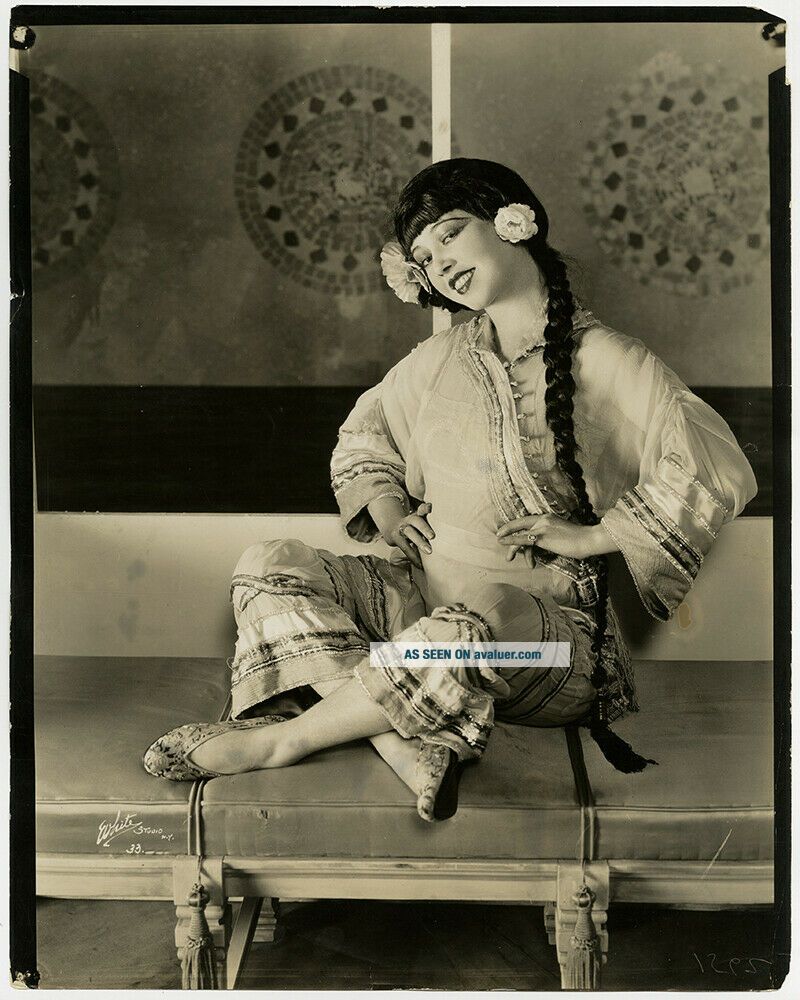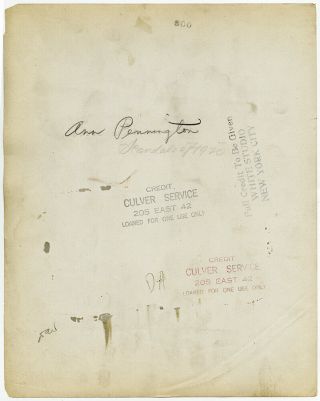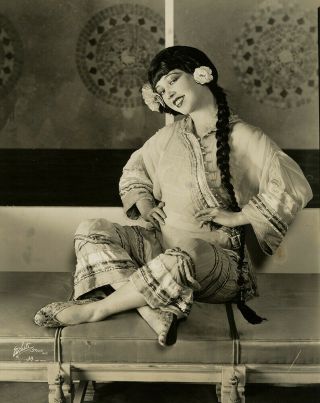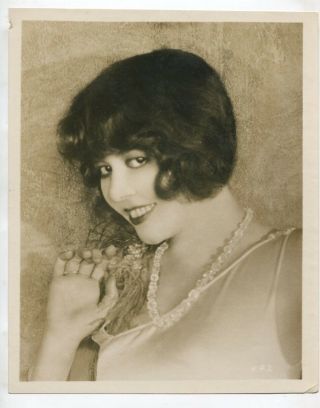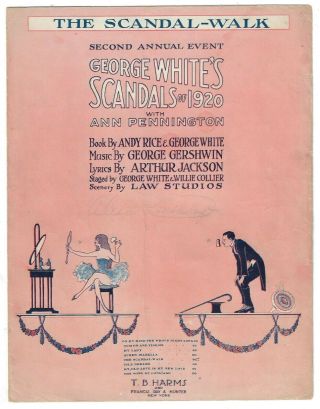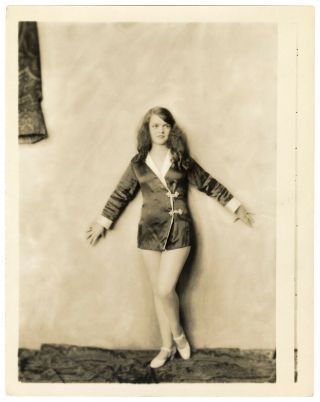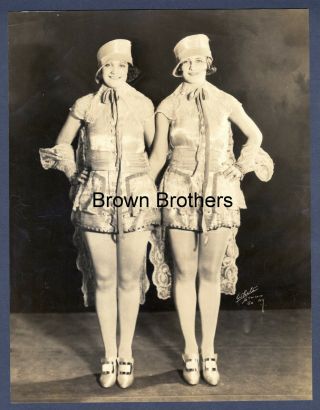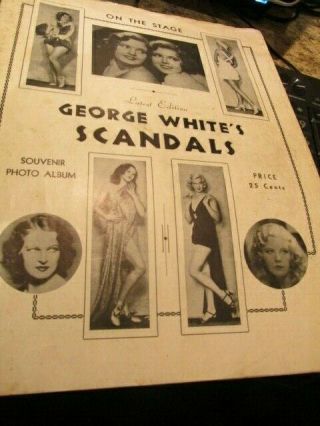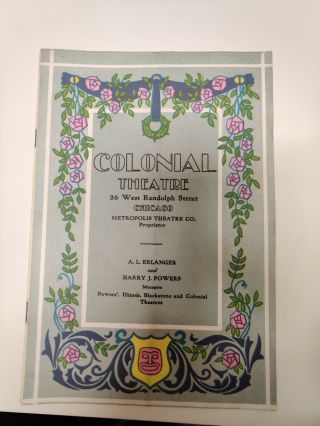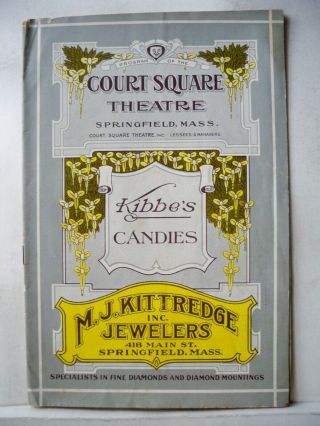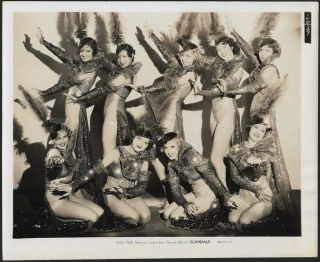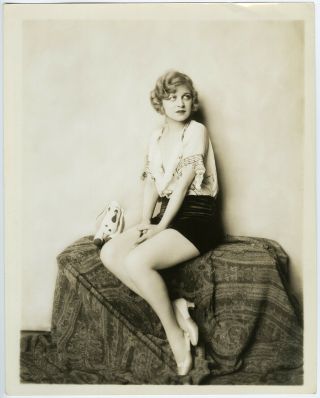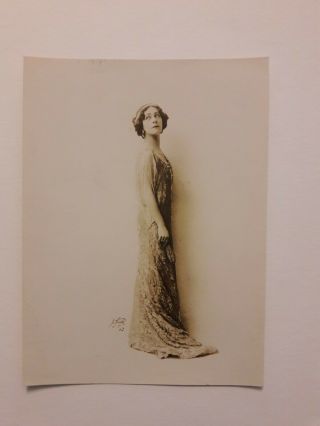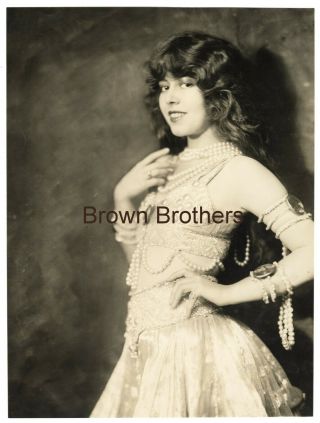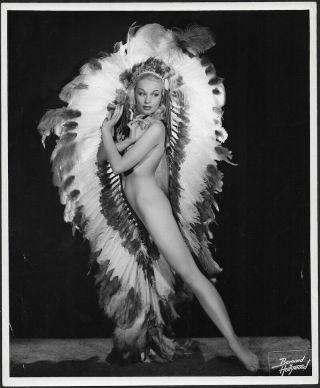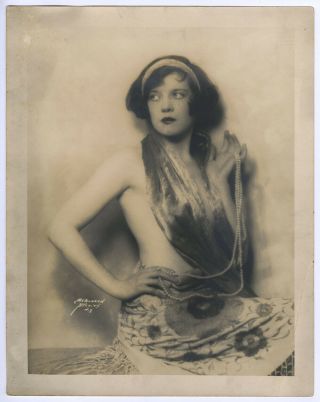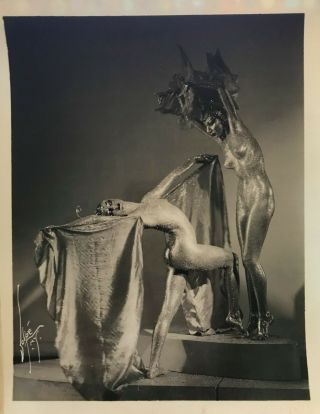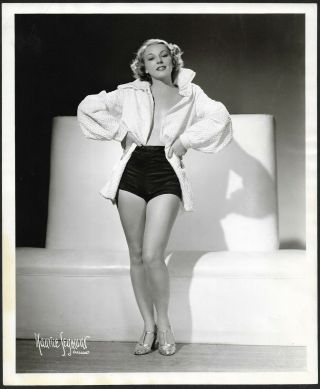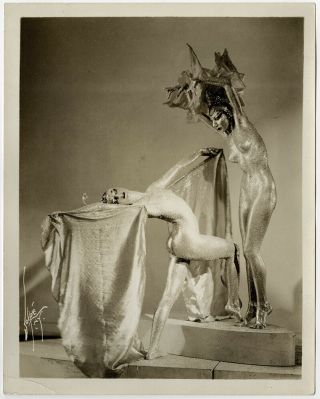George White ' S Scandals 1920 Ann Pennington Photograph Vintage Large Broadway
Item History & Price
Thanks to all our eBay bidders! We are honored to be your one-stop, 5-star source for vintage pin up, pulp magazines, original illustration art, decorative collectibles and ephemera with a wide and always changed assortment of antique and vintage items from the Victorian, Art Nouveau, Art Deco, and Mid-Century Modern eras. All items are 100% guaranteed to be original, vintage, and as described. Please feel free to contact us with any and all questions about the items and our po...licies and please take a moment to peruse our other great eBay listings. All sell no reserve!
ITEM: This is a vintage and original, large format photograph from New York City's premiere theatre photographers White Studios. This spirited and stylish Jazz Age portrait showcases the gorgeous and alluring Ann Pennington in Far East inspired wig and costume from her appearance in George White's Scandals (1920) at the Globe Theatre.
Known by many nicknames over the course of her illustrious career, she is perhaps best remembered as "the girl with the dimpled knees" which are on display in this delightful theatre portrait. Perhaps an odd body part to be excited about today, but in the early 20th century when hemlines were getting shorter, seeing a woman's dimpled knees were quite the treat! A fabulous jazz age theatre offering that is spectacular, as seen.
Measures 11" x 14" on a glossy, single weight paper stock.
Photographer's ink stamp, Culver Service ink stamps, and pencil notations on verso.
CONDITION: Fine condition with scattered corner and edge wear, including creasing and some areas of loss, as well as general storage/handling wear throughout. Please use the included images as a conditional guide.
Guaranteed to be 100% vintage and original from Grapefruit Moon Gallery.
••••••••••••••••••••
Ann Pennington (December 23, 1893 – November 4, 1971) was an actress, dancer, and singer who starred on Broadway in the 1910s and 1920s, notably in the Ziegfeld Follies andGeorge White's Scandals.
She became famous for what was, at the time, called a "Shake and Quiver Dancer, " and was noted for her variation of the "Black Bottom". She was also noted as an accomplished tap dancer. Ray Henderson wrote the extant version of "Black Bottom" for Ann - she had already been performing the popular version of the dance for some time. Some years prior to this, she had also topped the bill on Broadway in her performance of the musically similar "Charleston”.
Pennington also achieved fame as a star of both silent and sound motion pictures.
Anna Pennington was born in Wilmington, Delaware on December 23, 1893 and reputedly moved with her family to Camden, New Jersey around 1900. Her father worked for the Victor music company, they were Quakers, and she had at least one sibling, Nellie.She learned to dance with the Professor Wroe dance school, and her first performances in New York were as part of "Wroe's Buds". She wanted to be a classical actress, but her diminutive stature and talent as a dancer conspired against this ambition.
She began her career on Broadway as a member of the chorus in The Red Widow (1911) starring Raymond Hitchcock. Her debut in the Ziegfeld Follies was in 1913, where she quickly established herself as one Ziegfeld's top attractions.
With dimpled knees and long dark red hair, the petite, pretty, charming, and often scantly-clad Pennington stood a mere 4' 10" tall and wore only a size 1½ shoe. Because of her diminutive stature, she was referred to as "Penny" by her friends and colleagues. Her nickname for herself was "Tiny”.
During her years in the Ziegfeld Follies she appeared alongside the likes of Bert Williams, Eddie Cantor, Will Rogers, Fanny Brice (who became her closest friend), Marilyn Miller, and W. C. Fields. She switched back and forth between George White's Scandals and the Follies more than once, earning a salary of $1000 per week well before the 1920s, and continued to moonlight in the early New York film industry. She also frequented Harlem in its jazz heyday.
In the 1926 edition of George White's Scandals, Pennington introduced the African American-influenced Black Bottom dance to America at large with her partner, the eccentric dancer Tom Patricola. First popularized in New York by the African American show Dinaah that had been staged in Harlem in 1924, after Pennington performed the Black Bottom on Broadway, the dance became was a national phenomenon, overtaking The Charleston in popularity.
George Gershwin was her rehearsal pianist and wrote several songs for her. Cole Porter, Ray Henderson, Joe Burke, Oscar Levant and Edward Ward all wrote for her shows, The New Yorkers(1931) being her last great show for Porter. She could sing as well as dance, as evinced by her recording of "Believe Me" (1930).
No films of her signature dance routines have been preserved, with the possible exception of the "Snake-Hips" number which occurs in Happy Days (1929). Her key dances in Gold Diggers on Broadway (1929) remain lost. Some of her scenes from Tanned Legs still survive, but her role in The Great Ziegfeld, while still listed in some inventories, was in fact cut before release. She was also listed as a star in the 1929 Warner Brothers showcase movie "Show of Shows" but her routines were never filmed, perhaps because her main song and dance number "Believe Me" was commandeered by one of Warners' rising stars Irene Bordoni. Ann did however get to perform "Believe Me" in the 1930 movie "Hello Baby!", which is still in print, and sang and danced "You're responsible" in "Tanned Legs" (for which movie she features in uncredited cartoon form on the posters and sheet music).
The New York Times (November 5, 1971) noted:
She liked practical jokes. Once, when a man she didn't particularly like, telephoned, asking, "Is this Miss Pennington?" she replied, "This ain't me." Her dressing room door bore a sign, "For Men Only.”
She was until the late 1920s chaperoned at performances by her mother. She was noted for a quick and witty personality, but was said to be shy off stage and easily embarrassed, and in her latter years was loath to discuss her early life.
Pennington was romantically linked to several men during her lifetime, and at one time or another was allegedly engaged to boxer Jack Dempsey, theatrical producer and early dance partnerGeorge White, actor Buster West, and musician Brooke Johns. None of these romances lasted and Pennington never married. She never spoke on record about any of her engagements, whether to confirm or deny them.
Ann Pennington never settled in one place for very long. She lived mostly in hotels in New York apart from some years in California as the constant companion of Fanny Brice, whom she had helped out at least once with loans and gifts of jewelry. Ann was noted for her generosity and many of her loans were never repaid; however most of her huge earnings were wiped out over the years by betting at the racetrack, decades of hotel bills, and gifts to charities and churches.
After her years on stage and screen ended, Pennington toured in vaudeville. She retired from performing in the 1940s. She last appeared on stage in a benefit show for the armed forces in 1946. She had a committed work ethic, and worked wherever the opportunity arose, although as she aged and tastes changed, she ended her stage days in shabby theaters with low ranked dance companies. Home movie footage of her "Snake Hips" dance at the 1939 World's Fair survive, but is more memorable for her enthusiasm than her star quality in her fading years.
Ann Pennington died of a stroke in New York City on November 4, 1971, aged 77. She had lived alone on welfare for many years in New York hotels overlooking 42nd Street. She was badly affected by arthritis. She was sometimes recognized shuffling along Broadway as a faded superstar of a world long past- but she was also mugged in her old age on her daily walk to a diner. She is buried in the Valhalla Cemetery in New York. No family were known to have attended her funeral, which was paid for by the Actors Benevolent guild.
A few years before her death, she was asked what had been the greatest reward from her years of stardom, and her reply was "in living, honey”.
She was portrayed by actress Michelle Nicastro in the "Scandals of 1920" episode of The Young Indiana Jones Chronicles, which dramatizes her role as the star of George White's Scandals of 1920.
Of Ann Pennington's official film debut in Susie Snowflake, the New York Times stated on June 26, 1916:
Many of those who went to the Broadway yesterday for the first showing of Susie Snowflake will be inclined to endorse this particular nomination. Miss Pennington is obviously put forth as a diminutive star of the Marguerite Clark variety, a style enormously in vogue at the moment. She is little and cunning on Mr. Ziegfeld's stage and little and cunning on the screen. She has youth, a Mary Pickford like harum-scarum way with her and, except in the trying close-ups when her expression is somewhat adenoidal, she is pretty.
Of course she dances. As her frisky little dance is her sole claim to fame at the moment, it could no more be omitted from her first scenario than the "pump and washing tubs" in Mr. Crummles's theater. So as a child of the music halls adapted into a staid, old New England community, Susie Snowflake disrupts a church sociable by doing her Follies dance there in her terse Follies costume.
— Biography From: Wikipedia
••••••••••••••••••••
White Studios, Manhattan, New York
Biography By: David S. Shields
For twenty-years from 1905 to 1925 White Studio was Broadway's foremost photographer of stage production. Founded by New York saloonkeeper Luther S. White (1857-1936), this photographic agency employed a series of cameramen from 1903 to 1936, some talented, some not, who recorded hundreds of performers and thousands of productions of the American stage. The Studio was divided into two operations: the portrait studio located on Broadway and a mobile team of production photographers who hauled lights, tripods, and cumbersome Agfa and Kodak plate cameras to the dress rehearsals for stage pictures. Two great artists worked uncredited in the portrait studio: Edward Thayer Monroe during the 1910s and Ralph Shaklee in the 1930s.
For much White Studio's history, George Lucas was chief stage photographer. Lucas revolutionized production photography with the introduction of flash-pan photography, a method of illumination safer than 'flash-light' (magnesium powder, alcohol, ignited by blow torch) used by Joseph Byron, the chief stage photographer on Broadway from 1893 to 1905, before the ascendency of White Studios.
Luther White, proprietor of the studio, in later life claimed to have been a photographer. Lucas, however, stated that White never posed or processed photographs. He was a broker and businessman. As an entrepreneur, White was effective. When Joseph Byron and his Percy were experiencing differences of opinion in 1905, White bought the elder Byron's equipment and usurped his client list. White then secured an exclusive agreement with the Schubert organization to record their New York productions.
During the 1920s, the studio lacked the aesthetic panache of the most advanced theatrical image artists. Luther White no longer exerted himself with the energy of his younger years. In 1930, he took up raising Guernsey Cows on his farm in Connecticut. He turned over direction of the studio to his son, Dexter, in 1934. At this juncture, the most experienced artist, George Lucas, departed setting up Lucas-Pritchard with Irving Pritchard, the man who kept the books for White Studio. Lucas quickly determined he needed a creative collaborator rather than a financial guru, so called upon his old colleague at White from the World War I period, Edward Thayer Monroe. Lucas-Pritchard became Lucas-Monroe. White Studio's old clients gravitated toward the new partnership.
Perhaps from stress induced by presiding over a failing enterprise, Dexter White died of a heart attack on May 4, 1939, bringing an end to the studio. Its archive was secured by the Theater Collection of the New York Public Library. However, many of the earliest glass plates were destroyed during the First World War when donated to the War Department for recycling. David S. Shields/ALS
Specialty:
White Studios dominated production photography in the New York theater for two decades, specializing in frontal panoramas of theatrical action taken during dress rehearsals and occasionally during performances. Because the exposure of the glass plates required that casts remain motionless for as long as 45 seconds, the production shots from 1904-1913 seem wooden and pedestrian. George W. Lucas, chief location photographer, became more innovative and intimate during the 1910s.
White Studios also had a portrait department. Edward Thayer Monroe's depictions of the early Ziegfeld performers are quite artistic, including the iconic view of Bessie McCoy sitting on the Crescent Moon. Another noteworthy body of early works are Lucas's production views of "Chanticleer.”
— Biography By: David S. Shields c/o Broadway (dot) CAS (dot) SC (dot) edu
••••••••••••••••••••
00299



